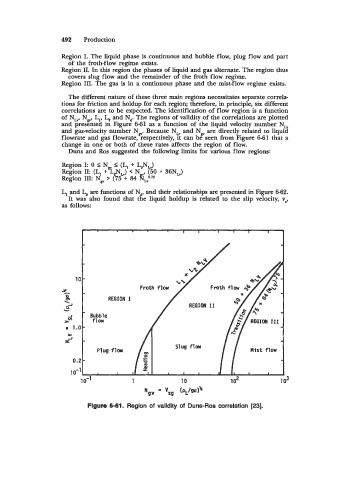Page 538 - Standard Handbook Petroleum Natural Gas Engineering VOLUME2
P. 538
492 Production
Region I. The liquid phase is continuous and bubble flow, plug flow and part
of the froth-flow regime exists.
Region 11. In this region the phases of liquid and gas alternate. The region thus
covers slug flow and the remainder of the froth flow regime.
Region 111. The gas is in a continuous phase and the mist-flow regime exists.
The different nature of these three main regions necessitates separate correla-
tions for friction and holdup for each region; therefore, in principle, six different
correlations are to be expected. The identification of flow region is a function
of N,, Ne, L,, Lz and N,. The regions of validity of the correlations are plotted
and presented in Figure 6-61 as a function of the liquid velocity number NLv
and gas-velocity number Ne. Because N, and Ngv are directly related to liquid
flowrate and gas flowrate, respectively, it can be seen from Figure 6-61 that a
change in one or both of these rates affects the region of flow.
Duns and Ros suggested the following limits for various flow regions:
Region I: 0 S NP I (L, + L,N,)
Region 11: (L, + L NLv) < N , (50 + 36NLv)
Region 111: Ngv 7 ($5 + 84 fiL>75
L, and 4 are functions of N,, and their relationships are presented in Figure 6-62.
It was also found that the liquid holdup is related to the slip velocity, vs,
as follows:
s
I I I I I I
-
10
%
B REGION I
\
2
P
Y
A Bubble
v) flow
I1 1.0-
>
2
L
Plug flow
-
0.2
10-1 I
Flgure 6-61. Region of validity of Duns-Ros correlation [23].

